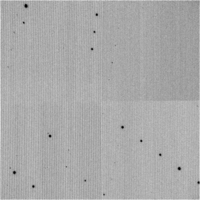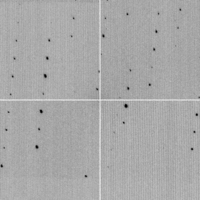|
From the session website: Very high resolution data can present a challenge for processing, as exemplified by this dataset from a crystal of triclinic hen egg-white lysozyme collected at 0.65 angstroms resolution. |
Content:
Running
% find_images
shows us that we have 60 images: p1lyso_a.0001.img to p1lyso_a.0060.img. We can have a closer look at the first image with
% imginfo p1lyso_a.0001.img
which returns
################# File = p1lyso_a.0001.img >>> Image format detected as ADSC ===== Header information: date = 30 Jun 2006 11:08:35 exposure time [seconds] = 4.000 distance [mm] = 400.012 wavelength [A] = 0.652549 Phi-angle (start, end) [degree] = -90.000 -87.000 Oscillation-angle in Phi [degree] = 3.000 Omega-angle [degree] = 0.000 Pixel size in X [mm] = 0.051294 Pixel size in Y [mm] = 0.051294 Number of pixels in X = 6144 Number of pixels in Y = 6144 Beam centre in X [mm] = 157.800 Beam centre in X [pixel] = 3076.383 Beam centre in Y [mm] = 160.200 Beam centre in Y [pixel] = 3123.172 Overload value = 65535
Judging from the large oscillation angle (3 degree), this seems to be a low-resolution scan for that particular project. Remember, we're only using a single scan for this tutorial, and not all data that is in principle available and that was used for the 2VB1 structure.
A quick check shows:
| Image | Full image | Centre region | Upper left |
| 1 |  |
 |
 |
| 31 |  |
 |
 |
Very nice spots - as expected fromm Lysozyme and a crystal that diffracts that well.
We can run autoPROC on these images with basically all defaults - only one parameter needs to be set (to tell autoPROC that the rotation axis rotates the opposite direction - this is a beamline/instrument specific setting required for autoPROC):
% process ReversePhi=yes -d 01 | tee 01.lis
This will result in a dataset
Summary data for Project: Test Crystal: A Dataset: 0.65255
Overall InnerShell OuterShell
---------------------------------------------------------------------------
Low resolution limit 28.850 28.850 1.697
High resolution limit 1.691 7.797 1.691
Rmerge 0.019 0.028 0.036
Ranom 0.017 0.042 0.040
Rmeas (within I+/I-) 0.024 0.059 0.057
Rmeas (all I+ & I-) 0.027 0.039 0.051
Rpim (within I+/I-) 0.017 0.042 0.040
Rpim (all I+ & I-) 0.019 0.028 0.036
Total number of observations 20429 208 160
Total number unique 10397 106 84
Mean(I)/sd(I) 38.5 47.0 22.7
Completeness 95.6 95.5 73.7
Multiplicity 2.0 2.0 1.9
Anomalous completeness 79.8 88.3 48.2
Anomalous multiplicity 1.0 1.0 1.0
and files:
Work in progress